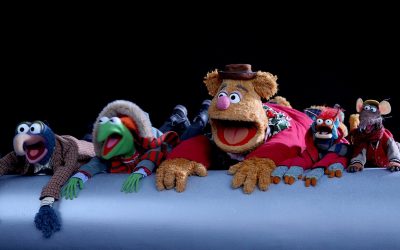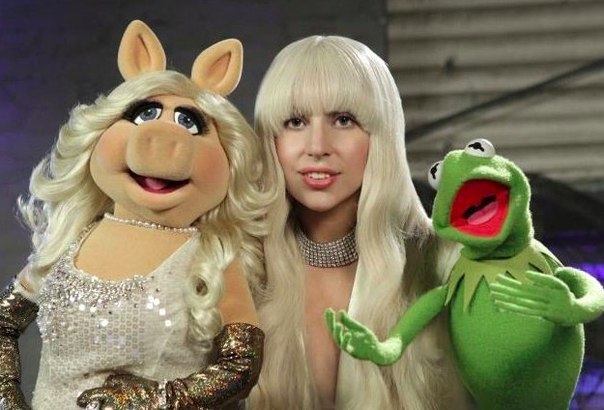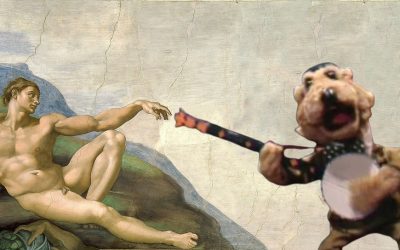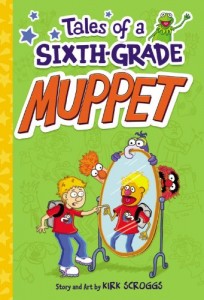 When we first heard about “Tales of a Sixth-Grade Muppet“, I admit I found the idea laughable. A young adult novel about a kid who turns into a Muppet, chock-full of forced cameos by the Muppets we all know and love?? It sounded more like a cheap attempt to cash in on the expected success of the new Muppet movie.
When we first heard about “Tales of a Sixth-Grade Muppet“, I admit I found the idea laughable. A young adult novel about a kid who turns into a Muppet, chock-full of forced cameos by the Muppets we all know and love?? It sounded more like a cheap attempt to cash in on the expected success of the new Muppet movie.
But thankfully (for me, for you, and for the good people at Disney licensing), “Tales of a Sixth-Grade Muppet” is a surprisingly fun, yet appropriately bizarre read.
The story is this: Sixth-grader Danvers Blickensderfer (an unfortunate name for both the character and the typesetter) is an academically underachieving, non-athletic, kinda sorta losery kid who happens to be obsessed with The Great Gonzo (sound familiar??). After an inexplicable phenomenon (do doo do do doo), he is magically transformed into a Muppetized version of himself, complete with wobbly arms, feathered hair, and a penchant for puns. Danvers’ quest to discover what happened to him takes him on a journey through a bunch of Muppet cameos and eventually an internship (unpaid, I’m sure) at the Muppet Show theater.
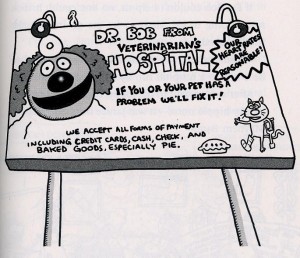 I’ve never read any of the “Diary of a Wimpy Kid” books, but I’d wager that this book is pretty similar. Even beyond the obvious character parallels between the geeky Danvers and the titular “Wimpy Kid”, “Sixth-Grade Muppet” is told as a mixture of first-person narration and Danvers’ own drawings. This gives us two views of almost every character, one drawn by artist Kirk Scr0ggs (who also wrote the book) and one by Danvers (so, y’know, also Kirk Scroggs).
I’ve never read any of the “Diary of a Wimpy Kid” books, but I’d wager that this book is pretty similar. Even beyond the obvious character parallels between the geeky Danvers and the titular “Wimpy Kid”, “Sixth-Grade Muppet” is told as a mixture of first-person narration and Danvers’ own drawings. This gives us two views of almost every character, one drawn by artist Kirk Scr0ggs (who also wrote the book) and one by Danvers (so, y’know, also Kirk Scroggs).
That leads me to my first minor complaint about the book, which is that these two artistic styles aren’t all that different from each other. Scroggs’ figures have an immature look to them, while Danvers’ are the same, but slightly shakier. Scroggs’ off-model characters don’t really bother me, as it makes sense in the context of the book (and to the audience, who probably skew a smidge younger than me), but I wish he’d make an attempt at making these two styles more independent of one another.
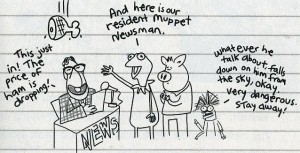 Danvers as the titular Muppet offers an interesting look at exactly what it takes to be a Muppet. He’s aware of the fact that he’s made of felt, but there are no references to being a puppet (or otherwise controlled by a performer). He’s punny, he’s reckless, his eyelids don’t close, and of course, he has a removable nose. The most entertaining of these stereotypes, however, is the fact that once he makes his transformation, he is stalked and pestered by Statler and Waldorf.
Danvers as the titular Muppet offers an interesting look at exactly what it takes to be a Muppet. He’s aware of the fact that he’s made of felt, but there are no references to being a puppet (or otherwise controlled by a performer). He’s punny, he’s reckless, his eyelids don’t close, and of course, he has a removable nose. The most entertaining of these stereotypes, however, is the fact that once he makes his transformation, he is stalked and pestered by Statler and Waldorf.
The hecklers show up throughout the book (driving their car past Danvers’ house, outside his classroom window, in the stands at gym class, etc.), while the other Muppets pop in and out as needed. Dr. Bob, Nurse Piggy, and Nurse Janice inspect Danvers after his Muppety infection before referring him to specialists Bunsen and Beaker, who are in residency at a school headmastered by Sam the Eagle, and so on and so forth. The gimmick got a little repetitive, but it only lasted until Danvers begins his Muppet Show internship, when the Muppet cameos become too common to be singled out. It’s fun seeing all the characters in familiar, yet new roles, and I can totally envision the Muppets doing something similar in future productions.
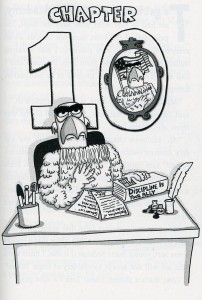 Though while most of the Muppets (including, but not limited to Rowlf, Dr. Teeth, Beaker, Pepe, Rizzo, Lew Zealand, and Crazy Harry) are written true-to-form with enough new material to keep them interesting, Scroggs misses the mark a little bit with some of the key characters. Kermit is bland and only appears to provide plot exposition (well, it has to go somewhere). Fozzie is relegated to telling a few bad jokes in passing. And Miss Piggy is all grumpy without a hint of saccharin. Gonzo, however, is written wonderfully (which is good, since he is the most visible Muppet in the book) with a great mix of his patented manic daredevil persona and tortured artist.
Though while most of the Muppets (including, but not limited to Rowlf, Dr. Teeth, Beaker, Pepe, Rizzo, Lew Zealand, and Crazy Harry) are written true-to-form with enough new material to keep them interesting, Scroggs misses the mark a little bit with some of the key characters. Kermit is bland and only appears to provide plot exposition (well, it has to go somewhere). Fozzie is relegated to telling a few bad jokes in passing. And Miss Piggy is all grumpy without a hint of saccharin. Gonzo, however, is written wonderfully (which is good, since he is the most visible Muppet in the book) with a great mix of his patented manic daredevil persona and tortured artist.
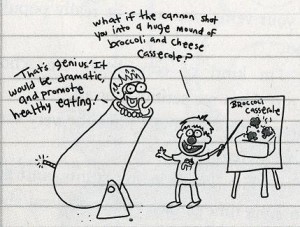 And like any other Muppet production, the characters we recognize aren’t the only Muppets in this world. Danvers’ schoolmates and fellow townspeople include not only humans, but cats and frogs and chickens and giant carrots too. Scroggs gives us a glimpse into a larger Muppet universe that gives a little logic to the fact that people can recognize the Muppets without screaming in fear at their horribly mutated forms or ability to talk and use opposing thumbs.
And like any other Muppet production, the characters we recognize aren’t the only Muppets in this world. Danvers’ schoolmates and fellow townspeople include not only humans, but cats and frogs and chickens and giant carrots too. Scroggs gives us a glimpse into a larger Muppet universe that gives a little logic to the fact that people can recognize the Muppets without screaming in fear at their horribly mutated forms or ability to talk and use opposing thumbs.
And that’s really the most satisfying part of the book: This is a world where The Muppet Show is real, frogs and bears and chickens and things can be found everywhere, the laws of physics (and logic) are flexible, and there’s a good chance you can actually meet Gonzo. If that universe actually exists, I’ll gladly spend the rest of my life searching for the wormhole that connects our two worlds.
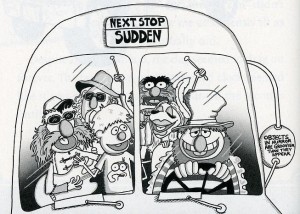 Though all this rampant Muppetiness does raise one question: Will the kids reading this book actually get all the references? I’m not talking about the Marvin Suggs or Gladys the Lunch Lady cameos, but the overall idea of The Muppet Show. Is this show that hasn’t been in syndication in over a decade-and-a-half and hasn’t seen a proper DVD release since 2008 well-known enough by America’s youth that they’ll know Veterinarian’s Hospital, the artistic history of Gonzo the Great, and the fact that the Muppets usually put on a “bad” show in their own continuity? I think Scroggs did a fine job in explaining everything as he writes, but it’s difficult to say for sure being the kind of person I am, assuming that everybody in the world is as intimately familiar with every episode of The Muppet Show as me.
Though all this rampant Muppetiness does raise one question: Will the kids reading this book actually get all the references? I’m not talking about the Marvin Suggs or Gladys the Lunch Lady cameos, but the overall idea of The Muppet Show. Is this show that hasn’t been in syndication in over a decade-and-a-half and hasn’t seen a proper DVD release since 2008 well-known enough by America’s youth that they’ll know Veterinarian’s Hospital, the artistic history of Gonzo the Great, and the fact that the Muppets usually put on a “bad” show in their own continuity? I think Scroggs did a fine job in explaining everything as he writes, but it’s difficult to say for sure being the kind of person I am, assuming that everybody in the world is as intimately familiar with every episode of The Muppet Show as me.
While “Tales of a Sixth-Grade Muppet” is most definitely aimed toward people shorter than me, I still found a lot to love in the book. It’s fun living vicariously through Danvers, meeting and getting to know the Muppet crew. The jokes are funny, the story is solid, and the entire concept feels fresh and retro at the same time. And it’s always satisfying to see another officially sanctioned product (much like most of the Muppet comic books) written by someone who is obviously passionate about the Muppets while being a student of their history at the same time. Although the book has little to do with the new Muppet movie coming out this November, it has raised my expectations for the film just a little now that I’m reminded that there are people out there who know how to breathe life into the Muppets in a fun and interesting way.
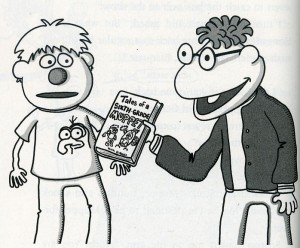
Click here to wake up feeling a little fuzzy on the ToughPigs forum!
by Joe Hennes – Joe@ToughPigs.com

